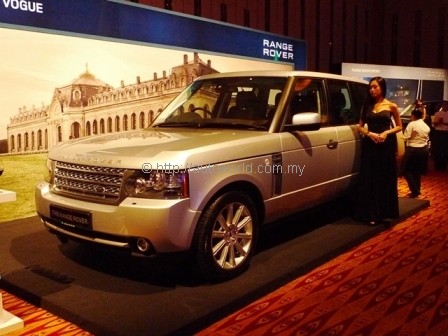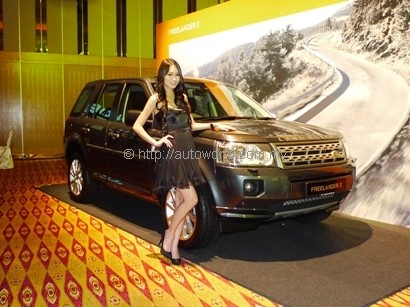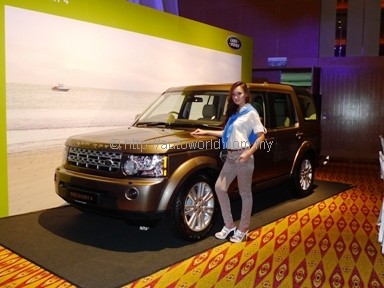Ranger Rover 4.4 litre Turbo Diesels join the Range Rover Line-up in Malaysia
Kuala Lumpur, July 23, 2011 – Just one month after the introduction of the Range Rover 5.0-litre Petrol Supercharged, Land Rover (Malaysia) Sdn Bhd has now unveiled the latest diesel-powered variant of arguably the most capable and luxurious sports utility vehicle (SUV) in the world.
The new 2011 Range Rover 4.4 LR-TDV8 turbo-diesel, which replaces the previous Range Rover 3.6 LR-TDV8, is expected to be priced at about RM730,000 on the road excluding insurance.
An all-new ‘super-diesel’, the LR-TDV8 combines superior power and massive torque with unparalleled levels of refinement.
With 313PS and 700Nm torque, the Range Rover’s new powertrain matches power with conscience, reducing CO2 emissions by an impressive 14 per cent. In terms of performance, the sublime new 4.4-litre diesel engine offers 15 per cent more power, economy and acceleration and 9 per cent more torque that the 3.6-litre model that it replaced.
However, the most impressive fact is that the combined cycle fuel consumption of the new LR-TDV8 4.4-litre is just 9.4 litres per 100 km, making this the first Range Rover ever to achieve this benchmark.
The new diesel engine is helped in this respect by its marriage to an impressive new, electronically controlled, ZF 8HP70, 8-speed automatic gearbox tuned by Land Rover engineers to combine silky smooth shifting with exceptionally rapid response and outstanding fuel economy.
The new transmission, the first ever 8-speed gearbox fitted in a Range Rover, is tuned to take advantage of the LR-TDV8’s low end torque with torque converter lock-up being selected as early as possible to reduce slip and energy loss. The wider ratio spread, tall overdriven top gear and the fact that no more than two internal clutches are open at any one time all contribute to improved fuel economy and emissions.
Transmission Idle Control disengages 70 percent of the drive when the vehicle is stationary and the engine is idling in Drive, significantly reducing consumption in the urban cycle.
This winning combination is enough to catapult the Range Rover from rest to 100 km/h in a mere 7.8 seconds. Available only on 4.4-litre LR-TDV8 models, this ‘smart’ transmission integrates with the diesel engine to deliver the most efficient operating regime in all conditions.
To reflect the performance of the new 4.4-litre LR-TDV8, this latest Range Rover diesel model is fitted with all-round ventilated discs to provide the immense stopping power required. The system comprises 380mm ventilated front discs with unique, lightweight aluminium six-piston opposed action monoblock calipers. The rear brakes are fitted with 365mm ventilated discs with single piston sliding calipers.
Inside the cabin, the changes are subtle yet immediately noticeable. Steering wheel mounted paddle shifts are now standard. In place of the traditional gear stick is the revolutionary Drive Select, a new rotary-dial operated gear selector that is raised upon ignition and lowered on switch-off. Entertainment is provided by a harmon/kardon® Logic 7 Premium Audio System with 14 speakers, widely acknowledged as one of the finest in-car audio systems in the world.
In terms of visual aesthetics, detail improvements to the exterior include new ‘Noble’ grilles and side vents. Dynamically, the Range Rover 4.4 LR-TDV8 is equipped with the last word in suspension systems incorporating Adaptive Dynamics technology that exercises firm control over the body through turns while cosseting the occupants with the svelte ride Range Rovers are famous for.
A new feature in the Range Rover 4.4 LR-TDV8 is the presence of a Terrain Response Optimisation Switch in place of the ubiquitous rotary dial. The award-winning Terrain Response system also features two further enhancements, Hill Start Assist (HSA) and Gradient Acceleration Control (GAC).
HSA retains the initial driver-generated brake pressure, long enough for the foot to move from brake pedal to throttle without the car rolling backwards. The brake is released after a sufficient time has elapsed or when the engine is supplying enough torque to move the car up the hill. Hill Start Assist is always available, not selectable and neither is its operation indicated to the driver.
GAC is designed to provide safety cover on severe gradients when the driver does not have Hill Descent Control engaged. By pressurising the brake system, GAC slows the car to a limit determined by the throttle position when the car is descending the slope in the driver’s intended direction of travel. This includes descending the slope forwards in drive, or rearwards in reverse. Otherwise (such as descending while facing up the gradient with Drive selected) GAC restricts speed to 5km/h for up to 20 seconds, allowing the driver to regain proper control.





























